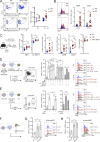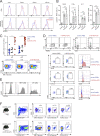Type I interferons drive MAIT cell functions against bacterial pneumonia
- PMID: 37516912
- PMCID: PMC10373297
- DOI: 10.1084/jem.20230037
Type I interferons drive MAIT cell functions against bacterial pneumonia
Abstract
Mucosal-associated invariant T (MAIT) cells are abundant in the lung and contribute to host defense against infections. During bacterial infections, MAIT cell activation has been proposed to require T cell receptor (TCR)-mediated recognition of antigens derived from the riboflavin synthesis pathway presented by the antigen-presenting molecule MR1. MAIT cells can also be activated by cytokines in an MR1-independent manner, yet the contribution of MR1-dependent vs. -independent signals to MAIT cell functions in vivo remains unclear. Here, we use Klebsiella pneumoniae as a model of bacterial pneumonia and demonstrate that MAIT cell activation is independent of MR1 and primarily driven by type I interferons (IFNs). During Klebsiella infection, type I IFNs stimulate activation of murine and human MAIT cells, induce a Th1/cytotoxic transcriptional program, and modulate MAIT cell location within the lungs. Consequently, adoptive transfer or boosting of pulmonary MAIT cells protect mice from Klebsiella infection, with protection being dependent on direct type I IFN signaling on MAIT cells. These findings reveal type I IFNs as new molecular targets to manipulate MAIT cell functions during bacterial infections.
© 2023 Lopez-Rodriguez et al.
Conflict of interest statement
Disclosures: P. Klenerman reported having acted as a consultant/advisory board member for UCB, AZ, Infinitopes, and Biomunex. No other disclosures were reported.
Figures









References
-
- Boulouis, C., Sia W.R., Gulam M.Y., Teo J.Q.M., Png Y.T., Phan T.K., Mak J.Y.W., Fairlie D.P., Poon I.K.H., Koh T.H., et al. . 2020. Human MAIT cell cytolytic effector proteins synergize to overcome carbapenem resistance in Escherichia coli. PLoS Biol. 18:e3000644. 10.1371/journal.pbio.3000644 - DOI - PMC - PubMed
Publication types
MeSH terms
Substances
Grants and funding
LinkOut - more resources
Full Text Sources
Molecular Biology Databases

